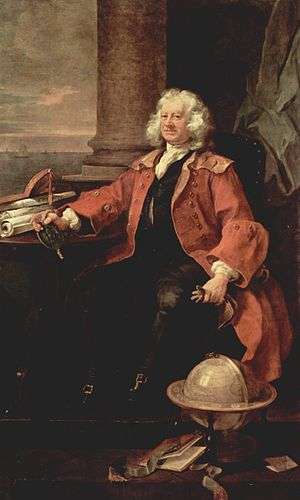1740 in Great Britain
| |
| Other years |
| 1738 | 1739 | 1740 | 1741 | 1742 |
| Sport |
| 1740 English cricket season |
Events from the year 1740 in Great Britain.
Incumbents
- Monarch – George II
- Prime Minister – Robert Walpole (Whig)
Events

Thomas Coram, painted by William Hogarth, 1740
- January and February - The “Great Frost” continues; this will be the coldest known year (and coldest twelve-month period) by average annual temperature across central England for which reliable records are known.[1]
- 26 June – War of Jenkins' Ear - Siege of Fort Mose: A Spanish column of 300 regular troops, free black militia and Indian auxiliaries storms Britain's strategically crucial position of Fort Mose, Florida.
- 1 August – The patriotic song "Rule, Britannia!" is first performed in an open-air performance at Cliveden, the country home of Frederick, Prince of Wales[2] as part of the masque Alfred with music by Thomas Arne to a lyric by Scottish-born poet James Thomson; the original tenor soloist is probably Thomas Salway.
- 21 August – First issue of grog in the Royal Navy.[3]
- 18 September – George Anson sets out on his voyage around the world from Spithead.[2]
- November – Hertford College, Oxford, is founded for the first time.[4]
- 6 November – Samuel Richardson’s popular and influential epistolary novel Pamela; or, Virtue Rewarded is published in London.
Unknown dates
- By an act of the Parliament, alien immigrants (including Huguenots and Jews) in the colonies) receive British nationality.
- Henry Hindley invents a device to cut the teeth of clock wheels.[2]
- William Hogarth paints a portrait of Captain Thomas Coram (pictured).[2]
- A now-discredited account by William Stukeley asserts that Stonehenge was built by druids.[5]
- Thomas Witherby establishes his stationery business in London, specializing in printing and publishing for the marine insurance industry. By the end of the first decade of the 21st century, as Witherby Seamanship, it will claim to be the oldest independent publisher in the English speaking world.
- James Whatman establishes his paper mill in Maidstone, specializing in quality paper. It will remain in production until 2014.[6]
Births
- 17 September – John Hamilton Mortimer, painter (died 1779)
- 29 October – James Boswell, author (died 1795)
- 24 November – John Bacon, sculptor (died 1799)
- c. December – Francis Light, founder of the British colony of Penang (died 1794)
Deaths
- 23 April - Thomas Tickell, writer (born 1685)
- 6 June - Alexander Spotswood, governor of Virginia Colony (born 1676)
- 17 June - Sir William Wyndham, politician (born 1687)
- 20 December - Richard Boyle, 2nd Viscount Shannon, military officer and statesman (born 1675)
References
- ↑ "Monthly Mean Central England Temperature". Retrieved 2014-12-03.
- 1 2 3 4 Williams, Hywel (2005). Cassell's Chronology of World History. London: Weidenfeld & Nicolson. p. 308. ISBN 0-304-35730-8.
- ↑ Pack, A. J. (1982). Nelson's Blood: the story of naval rum. Havant: K. Mason. ISBN 0-85937-279-0.
- ↑ Hibbert, Christopher, ed. (1988). The Encyclopædia of Oxford. London: Macmillan. p. 182. ISBN 0-333-39917-X.
- ↑ "Icons, a portrait of England 1700-1750". Archived from the original on 2007-08-17. Retrieved 2007-08-24.
- ↑ Chalmers, Mark (September 2016). "Whatman - Springfield Paper Mill, Maidstone". Archive. Witney: Lightmoor Press (91): 52–65.
See also
This article is issued from Wikipedia - version of the 9/10/2016. The text is available under the Creative Commons Attribution/Share Alike but additional terms may apply for the media files.